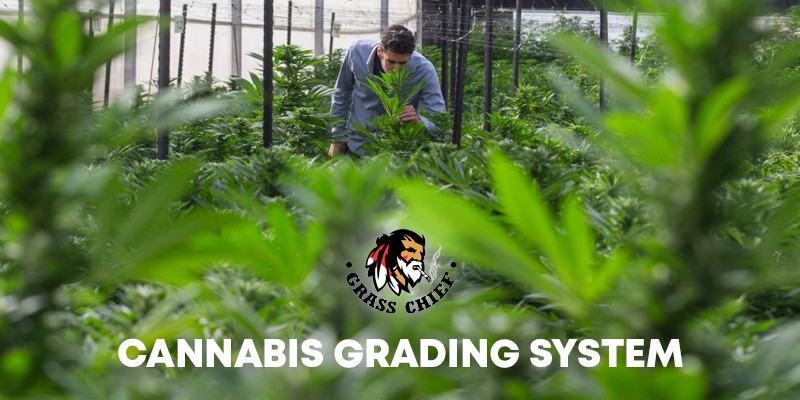Whether you are a long-time user, or simply new to the cannabis industry, there is one thing which you will quickly learn to judge. That is, the quality of your weed. With such a demand in the current market, thanks in part to the legalization of cannabis in Canada, it will come as no surprise to learn that this means an increase in the number of low-quality batches out there. What signifies quality then, and how can we differentiate between each grade of cannabis quality? – This is where the quality of weed grading system comes into play for many.
We will try our best to explain each level in some detail so that the next time you are choosing from a range of strains, you will have a better idea of their quality level. One more thing to point out before we get into the levels is, each cannabis strain could come in a number of different levels depending only on how that particular batch was grown. Therefore, the grading system is not a reflection on the strain itself, merely the grower and quality of that particular batch.
The Different Levels and Grading You Can Expect to See
When it comes to the cannabis industry, you may find a variety of different grading systems depending on who the seller is. This is quite normal to find, although they can be very subjective. Reference has been made by others to a kind of “Good Better Best” system within cannabis grading.
In Canada though, things are a little better planned and trustworthy when it comes to cannabis grading systems. While there is still not just one central system which is completely objective, the one which is most widely used and respected among experienced experts in cannabis is the A-AAAA grading system.
As you would expect, there can be a vast difference in quality through the different levels from A-AAAA. Bearing in mind that single A is the lowest, and quadruple A is the highest grading. Here we will take a run through each grading level and try our best to give you a good idea of what you can expect in terms of weed quality. It should also be noted that the most common top quality of weed which you may have already sampled is usually classified as AAA. That is not to say that AAAA is an unachievable benchmark, just that it is relatively rare to come across.
Cannabis Grading System Guide – AAAA
This AAAA cannabis grade level will typically be the best of the best available. If you shop around you can find several great strains at this high level. This is the stage at which everything aligns for a strain. This means that the smell, look, and taste of the cannabis should be reaching near perfect levels in order to receive a quad A rating. Indica vs Sativa vs Hybrid is no matter here, the rating system is judging quality.
What does that situation look like? Well, in terms of smell, it should be pungent and pleasing. There should be no unintended off notes when it comes to the aroma. The structure of the bud and presence of plentiful trichomes is important when considering the look of a top-quality strain. These trichomes are the tiny, hair-like features which you will see. The buds themselves should be dense and well-kept in form, with a hint of orange or purple, everything looking neat and well-packed.
Presence of a poor-trim or less than healthy coloration ultimately means the level is not quite as high. When it comes down to taste, one which compliments the aroma, without a harsh aftertaste is the minimum which can be expected from the highest graded level of cannabis. When it comes to our strains, Blue Coma, and Black Cherry punch are two which stand out as AAAA grade strains.
AAA Grade
As mentioned, AAA grade cannabis is probably the most common you will see when making a purchase. This level would be what most consider as standard. It can still be of really excellent quality, and you can always rely on a varied selection of AAA grade to be available almost all of the time from any respectable location.
In order to be thought of as AAA quality, many of the same qualities as the highest level still need to be present. There is some room for less density in terms of the buds themselves, and a little more discoloration can be expected, although not enough to include too much brown or tan.
The levels of THC in a particular strain are not important when determining the grade. The main elements to identify would be how it looks, how it smells, and how it tastes. The potency will also come through easier in grades of a higher level. As AAA is still at an extremely high level, you can expect it to deliver almost maximum potency and trust that you will feel the full effects of the THC contained within it. If you ask around to those who ae experienced users, you will also find that they would rarely consider purchasing anything below this level. At Grass Chief, we are proud to offer only these top two grades of cannabis for your enjoyment. Death Bubba, and Platinum Blackberry are two very popular choices at this level which are currently available.
AA Grade
If your budget is restricted, you may find yourself venturing down the path of lower quality. AA grade is typically seen as a very budget choice. The old saying of, “you get what you pay for” comes into play here. While you may stumble upon a rare good selection in this category, this should definitely not be expected.
The quality of the strain is much more likely to be on the poor side, with a lot of brown or other off-color appearances. The smell is also likely to be quite a way from what you would get with just one step up in grade level. The lower the grade quality, generally, the darker the ash also becomes.
Purchasing anything less than an AAA grade may surely save you money in the short-term, but will also be a sacrifice of quality which can be hard for some to enjoy, particularly those who are accustomed users which typically means they have experienced higher levels in the past. You could also expect that some of the noted effects at this level would not be as strong or predictable.
A Grade
At this level, you are really scraping the bottom of the barrel in terms of weed. Many would suggest you are even better off not consuming products of this level as it may give you an unrealistic impression of what the experience of top-quality weed is really. An A grade level of cannabis is really nothing more than very low quality of weed product. In many cases, vendors will use flower to make extracts our of it, and then sell the flower corpse to their clients for extra profit. This means that the flower would be butane blasted for shatter production first, and then the bud gets sold since it still looks ok. We would also recommend other selections if you have resorted to purchasing at this quality tier. Perhaps you can reduce your purchase size in order to increase the level of quality you can afford. At any rate, even a strain which seems to be great value at this level is not representative of what you can expect to find when it comes to quality at the other higher grade levels.
Can You Notice the Difference in Grade Levels and Does it Matter?
As we have covered, there is a big difference between the grade levels of cannabis in a few areas. These are mainly taste, smell, and how it looks. As a more experienced user it is certain that you will notice the difference when presented with these different grades. These may be subtle between AAAA and AAA, but venture down to the lower two tiers and you will certainly see a large gap appear in terms of quality.
If you are a less experienced user, you may not directly be able to put your finger on why there is a difference, but you would certainly be able to notice it.
The question of whether it matters is really down to you. As experienced users, we would certainly say that it matters a lot. Just as with many products, you want the best quality and experience with your purchase. This is something with the top two grades available through the Grass Chief store can almost guarantee. If you want to experience the full quality and effects as they are described, then AAAA and AAA grades of cannabis really are the only choice you can make.
Final Thoughts
And there we have it, something which you may never have deeply considered or understood in the cannabis grading system, explained in simple, convenient terms. This system is not the only one out there, and as with all systems, it is quite subjective in nature, but it is a great starting point nonetheless. This is a benchmark which you can use for future purchases which allows you to have some degree of faith in the products you are purchasing and the quality within them.


